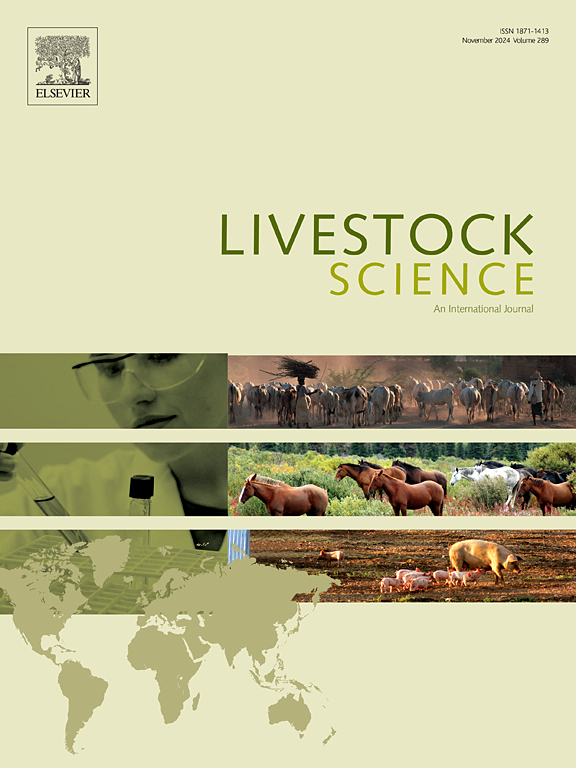Investigation of apparent digestibility, caecal fermentation and microbiota of rabbit fed with raffinose
IF 1.9
3区 农林科学
Q2 AGRICULTURE, DAIRY & ANIMAL SCIENCE
引用次数: 0
Abstract
The present study aimed to investigate the influence on caecal microbial communities of the supplementation of raffinose (RA) in rabbit's diet, also considering apparent digestibility and caecal fermentation. Rabbits (n = 120) with a similar weight were randomly divided into four groups and fed a basal diet (RA0) and a basal diet supplemented with 0.5 g/kg RA (RA0.5), 1 g/kg RA (RA1) and 2 g/kg RA (RA2), respectively. 16 s rRNA high-throughput sequencing of the V3–V4 segment of the bacterial was performed on each group (n = 6). The results showed that, compared with the control group, dietary 0.5 g/kg RA inclusion improved the digestibility of crude protein (CP) (P < 0.05). Meanwhile, the proportion of volatile fatty acids, including propionate and butyrate, in the RA0.5 and RA1 groups were increased compared with the RA0 group (P < 0.05). Moreover, the microbiota diversity and richness of the cecum in RA0.5 group were significantly higher than other groups (P < 0.05). Furthermore, at the phylum level, dietary 0.5 g/kg RA increased the relative abundance of Bacteroidetes and Actinobacteria (P < 0.05); At the genus level, feeding 0.5 g/kg RA increased the relative abundance of Subdoligranulum (P < 0.05). Phylogenetic investigation of communities by reconstruction of unobserved states (PICRUSt) analysis revealed potential metabolic changes associated with RA treatment, the microbial genes involved in the chlorocyclohexane and chlorobenzene degradation, phosphonate and phosphinate metabolism and methane metabolism pathways were all decreased in the present study (P < 0.05). Overall, diet supplemented with 0.5 g/kg RA is effective in improving CP digestibility and caecal fermentation, optimizing the cecum microflora of rabbits.
饲喂棉子糖家兔表观消化率、盲肠发酵及微生物群的研究
本研究旨在探讨饲粮中添加棉子糖(RA)对家兔盲肠微生物群落的影响,同时考虑表观消化率和盲肠发酵。选取体重相近的120只家兔,随机分为4组,分别饲喂基础饲粮(RA0)和在基础饲粮中添加0.5 g/kg RA (RA0.5)、1 g/kg RA (RA1)和2 g/kg RA (RA2)的试验饲粮。对每组(n = 6)进行16 s rRNA高通量测序。结果表明,与对照组相比,饲粮中添加0.5 g/kg RA可提高粗蛋白质(CP)的消化率(P <;0.05)。与RA0组相比,RA0.5和RA1组挥发性脂肪酸(包括丙酸和丁酸)的比例升高(P <;0.05)。此外,RA0.5组盲肠微生物群多样性和丰富度显著高于其他各组(P <;0.05)。此外,在门水平上,饲粮添加0.5 g/kg RA可提高拟杆菌门和放线菌门的相对丰度(P <;0.05);在属水平上,投喂0.5 g/kg RA可提高亚穗核的相对丰度(P <;0.05)。通过PICRUSt分析对群落进行系统发育调查,发现与RA治疗相关的潜在代谢变化,参与氯环己烷和氯苯降解、膦酸盐和膦酸盐代谢和甲烷代谢途径的微生物基因在本研究中都减少了(P <;0.05)。综上所述,饲粮中添加0.5 g/kg RA可有效提高肉兔CP消化率和盲肠发酵,优化盲肠菌群。
本文章由计算机程序翻译,如有差异,请以英文原文为准。
求助全文
约1分钟内获得全文
求助全文
来源期刊

Livestock Science
农林科学-奶制品与动物科学
CiteScore
4.30
自引率
5.60%
发文量
237
审稿时长
3 months
期刊介绍:
Livestock Science promotes the sound development of the livestock sector by publishing original, peer-reviewed research and review articles covering all aspects of this broad field. The journal welcomes submissions on the avant-garde areas of animal genetics, breeding, growth, reproduction, nutrition, physiology, and behaviour in addition to genetic resources, welfare, ethics, health, management and production systems. The high-quality content of this journal reflects the truly international nature of this broad area of research.
 求助内容:
求助内容: 应助结果提醒方式:
应助结果提醒方式:


